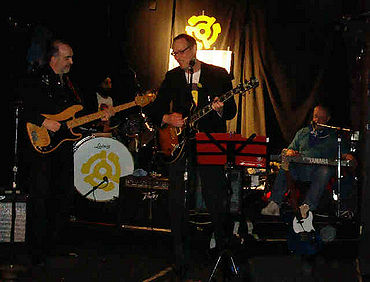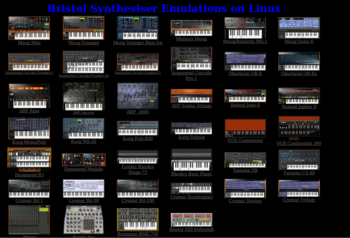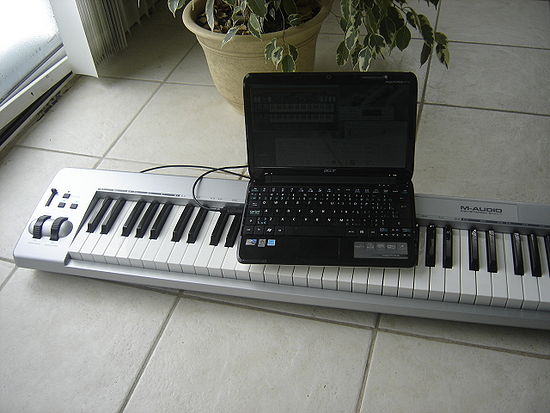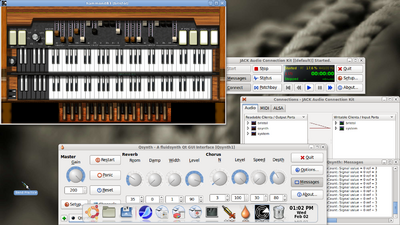Performing Live with Jack,Qsynth, and Bristol Organ
Contents
Purpose of This Resource
To Demonstrate how Ubuntu Studio can be used for live keyboard performances on a netbook computer...
Background
After playing keyboards in "garage bands" for over 2 decades, I have learned to "Keep it Simple"... the less you have to bring and setup - the better.. and I have tried everything including an ironing board for a keyboard stand!
I have recently kept my performance set-up to a minimum:
- Midi Keyboard / usb cable
- Netbook Computer (running Ubuntu Studio), power-chord, Audio Adaptor cable
(from netbook to Amplifier). - Folding chairs (one chair to seat myself while the keyboard sits on my lap, and another chair to hold my netbook computer)
That's it! This method has worked for me for years (except I am now using a net-book computer, and will be bypassing the Tascam US122 USB/MIDI device since I now have a USB musical keyboard)...
... Here is a picture of myself (and keyboard setup) along with our band called "The Lucky Bleeders" performing at the Cameron House in Toronto, ON, Canada a few years back...
I have viewed many Internet posts indicating the "struggles" or "frustration" of finding a way to perform live in the Linux environment.
The answer is that it can be done, it just takes some knowledge of some Linux commands to launch and start Jack audio server, as well as launching some keyboard emulators, and finally making the appropriate connections (patches) to the keyboard and amplifier via the Jack audio server.
I will discuss in this WIKI how to use Linux Ubuntu Studio for live performances. Contrary to other Internet postings, you don't have to use an application such as Reaper (although that approach would make it more user-friendly for non-Linux users or "Newbies"). Instead, a well-written Bash shell script can be used to launch Jack and necessary keyboard applications such as Qsynth (Piano, and other sound-font voices), as well as Bristol Organ Emulator (Hammond B3, Vox, Rhodes Piano, Phophet5, Juno, Moog, etc).
Therefore, you can switch to different voices by switching to different transmitting MIDI channels,which may be more convenient than pointing and clicking on an instrument icon via the Reaper or Cubase applications (which are not free applications). Also, applications such as Bristol Organ allows a user to sync midi controller buttons or sliders (on the keyboard) to change control settings on the emulated organ by middle-clicking the mouse on the emulated keyboard's control knob and moving or activating the midi controller on the keyboard.
I have used MS Windows OS with Native Instruments Hammond B4, and other Native Instruments applications, so I have some experience when comparing open-source software against proprietary software (i.e. pros vs cons).
Setting up My Netbook
Here is a step-by-step guide to installing and configuring my netbook computer to run Ubuntu Studio:
Hardware / Software Setup
I'm "pulling-out all the stops". I have decided to test the power of the Acer Aspireone netbook for live performances. It would have the advantage of small size and weight.
Here is my Hardware/Software Information:
Hardware (Acer Aspireone netbook) and Peripherals:
- Model 715h Wireless (ZA3)
- 11.6 inch screen
- 1 GB RAM (expandable to max of 2 GB - I will upgrade to 2 GB in the future)
- 160 GB Hard Drive (80 GB dedicated to Linux Ubuntu Studio - Dual boot Linux,MS Windows XP)
- MAudio 61 Keystation (USB interface)
- Tascam US122 USB interface (Optional, and can be replaced with 1/8 " stereo jack to 1/4 " mono jack into the AUX input of Amplifier)
Software (Ubuntu 10.10 Netbook Remix) Ubuntu Studio applications include:
- Realtime Kernel
- Jack Audio Server
- Qsynth (Graphical Frontend for Fluid Synth)
- Bristol Organ Emulator
- Swamy Sound Font Editor
Setup / Configuration
I obtained the Ubuntu Netbook version for Ubuntu: [ http://www.ubuntu.com/netbook/get-ubuntu/download ]
I didn't worry about Ubuntu Studio or loading updates - I would recommend to follow "MY SEQUENCE" (listed below):
- I need to setup my 11.6 inch screen Acer Aspireone after install. I have noticed that the video card chipset is different than the older 10 inch screen model (ZA3). Although a "pain", I followed some of the steps from the Ubuntu resource for the Intel GMA500 "Poulsbo" video driver: [ https://wiki.ubuntu.com/HardwareSupportComponentsVideoCardsPoulsbo#karmic ]
From with resource, I performed the following:
- Opened terminal and ran the command:
sudo add-apt-repository ppa:gma500/ppa && sudo apt-get update && sudo apt-get install poulsbo-driver-2d poulsbo-driver-3d poulsbo-config - Rebooted the computer.
- After reboot, then installed updates (ie. Ran "update manager" from Admin).
- Rebooted the computer.
- Ran Synaptic Package Manager (from Admin), and installed Ubuntu Studio Desktop (I selected ALL packages associated with Ubuntu Studio).
- Followed instructions to make my Tascam US122 device work with my netbook: [ https://help.ubuntu.com/community/TASCAM_US-122 ]
- Opened terminal and ran the command:
- I "Tweaked" the appearance of my Gnome Desktop like running the Avant Window Navigator (docking panel appearance like Mac OSX), and removed the "old-style" gnome-panels. Here is a resource that I created to help: [ Replacing Panels with Docking Station (awn) ]
- Now that you have Ubuntu Studio on your machine...
Here are some guides that I have written to help you get started
(even provides some basic recording session information):
This is assuming that you are using the Tascam US122 usb interface:
The organ emulator called Bristol Organ can simply be run via the startBristol command (after the Jack audio server has been started). To simplify the process of starting jack audio server, launching and making input/output connections for both Qsynth and several Bristol Organ emulations, it is easier to place commands into a Bash shell script and run shell script as a program! Please see next section for an example of how I did this...
FYI, the Maudio Fasttrack Pro is a good usb interface and "works out of the box" (after a couple of Jack server settings)... There is also a cheaper version for approx $87 CDN, but lacks MIDI connection (which may not be a problem since newer MIDI musical keyboards are USB anyways...)
Since I want to keep things simple, I have decided to not use any USB peripheral (other than the USB midi musical keyboard), and connect the netbook audio output directly to the amplifier. This can be done with the use of a 1/8 " stereo to 1/4 " mono "Y-adapter" which can be purchased from "The Source" or from certain "Dollar Stores".
Here is a link to the Y-adapter for reference: [ y-adaptor ]
(You can also buy a short 1/8 inch stereo extension cable if you feel uncomfortable plugging the Y-adapter directly into your net-book audio jack).
YouTube Tutorials
Here are some links to good YouTube videos demonstrating Jack audio server, and various synths:
About Jack audio server: [ http://www.youtube.com/watch?v=fMz6fDGBnA4 ]
CPU Scaling - Part I [ http://www.youtube.com/watch?v=Bn6g_YCxq2o ]
CPU Scaling - Part II [ http://www.youtube.com/watch?v=wAq4ihIhivg&NR=1 ]
Jack audio server & Synth I: [ http://www.youtube.com/watch?v=iVPr6iUuO3g ]
Jack audio Server & Synth II: [ http://www.youtube.com/watch?v=YHR9hQVrRIQ ]
Qsynth Synth & Sound Fonts: [ http://www.youtube.com/watch?v=vdtWYsUSK8s ]
LMMS Synth: [ http://www.youtube.com/watch?v=boRmY9jH7fs ]
"Putting it All Together" with a Bash Shell Script
One *perceived* problem that a typical "end-user" would face is having to manually connect (patch) various Devices (like a keyboard), with various keyboard emulators (like Qsynth and Bristol organ). But it is important to realise that these "graphical applications" are just convenient "front-ends" or user-friendly graphical representations of Linux commands.
Since they are Linux commands, these command, to launch and make patches (connections), and simply be added to a file (called a shell script), and run like program (either as an desktop icon), or a start-up program from boot-up.
For reference, here is a link to my Bash Shell script: [ txt ]
For additional reference, here is a link that explains how above shell script works: [ coming soon ]
Using Ubuntu Studio for Live Performances
To be completed...
Sound Font Editing in Linux
Note: The Swamy sound-font editor allows me to build or modify sound fonts. I must admit that I'm not an expert on sound-fonts.
In the future, I will discuss how to use a sound-font editor to create your own sound-fonts (instruments) to play with the keyboard.
Here is a link to the Project Swamy Webpage: http://sourceforge.net/apps/mediawiki/swami/index.php?title=Main_Page
Results / Discoveries
My net-book system works well (to my surprise). I will be taking my hardware set-up to band practice next week to make certain it works for the entire practice. I will keep taking it to practices and monitor my netbook's performance until I am confident to use for live "gigs". So far, so good...
Tips, Pros & Cons
Jack & High CPU Usage (and Potential Solution)
I am content to use the Bristol Hammond B3 keyboard emulator, and Q-synth (with sound-fonts) for piano, electric piano and other types of instruments. I will only notice some distortion if I simultaneously strike many keys on the keyboard (which I seldom do)...
I have also noticed when running other Bristol keyboard emulators, the CPU usage is very high in the Jack audio server - this can cause sound distortion. This is no doubt attributed to the limited power of the arm processor - adding RAM will not have a considerable impact on the quality of multiple Bristol emulators.
There is a method to change your Acer Aspireone into "performance mode" in order to keep CPU Usage within acceptable levels. By default, Ubuntu has set the default CPU frequency (i.e. performance) of newly installed computers to "On Demand". This is for a number of reasons including not constantly requiring fan to draw down the battery (although I would be plugged in for practice and performance anyways). The Acer Aspireone a751h CPU has the "speedstep" feature, and will now show the step to change it to "performance".
Steps to Enhance CPU performance:
- Take time to read these instructions. Flashing BIOS can come with risks, but this procedure did work for me...
- Check BIOS version. I had version 3010, which didn't support "speedstep" feature, but version 3012 does (which means you need to download version, and flash your BIOS).
- I have dual boot, so decided to perform the BIOS flash in my MS WIndows XP portion of notebook:
- Boot netbook into MS Windows (not Ubuntu Linux)
- Go to following page to download most recent BIOS version from ACER webpage: [http://support.acer.com/us/en/product/default.aspx?tab=5&modelId=1112]
- Unzip the file folder in c:\windows\system32
- Make certain you are logged into MS Windows as administrator (if you have not created password for account, you should do so, or procedure may not work!)
- Use Windows Explorer to navigate to the BIOS subdirectory you unzipped, and proceed in the subdirectory called Windows.
- Right-click on the WinPhlash file and then select Run.
- You will be prompted for authorization. Select by account, then enter your administrator account name and password.
- Carefully read all instructions before proceeding with flashing your BIOS. Your machine should be plugged in. It would be a bad, bad thing if your machine is powered off in the middle of flashing your BIOS! The decision to flash you BIOS is yours, not mine.
What I Love About Open-Source Applications
What I really love about open-source applications is being able to communicate with many of the software developers.
I have even suggested an improvement to an application that was implemented immediately!
Here is a link to e-mail correspondence to Nick Copeland, developer of the Bristol Organ emulator (open source equivalent to Native Instruments B4, Electrik Piano, etc...)
[ Correspondence with Nick Copeland ]
Is it Worth It?
In my opinion: YES!
I cannot begin to imagine the amount of money that I have saved as a result of using Linux Ubuntu Studio. I have rolled back the money that I saved to help build my basement recording studio (and will never worry about software costs in the future!). No doubt, I should start donating to these developers to acknowledge their great products!
I realize that I have an unique advantage from having taught Unix and Linux courses over 2 decades, although Linux is becoming easier to use, and the on-line support networks are becoming better. I have tried to "spread the word" about using Linux and open-source applications over many years. I have had some great success and some failures in this campaign. I consider that it comes down to an issue of empowerment:
Either take the time to learn how to use open source applications, or become dependent and accept the cost of letting others do the thinking for you...
Here is one of my previous blog posts that explains my position on open-source software: [ http://murraysaul.wordpress.com/2010/01/22/hacking-can-be-a-good-thing/ ]



